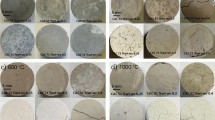Abstract
Subcritical crack growth and crack closure are analysed using the double cleavage drilled compression method, in two calcium phosphate-based glasses. The measurements of the crack velocity as a function of temperature, from ambient to 250 °C, are reported for two different relative humidity levels. Studied glasses present unusual trends characterized by a non-gradual shift of V–K I curves versus temperature. Moreover, when the load is released and crack closes, expulsion of a “liquid-like” phase is observed forming droplets along the crack path. These droplets are only formed at certain temperatures, but both under high and low water humidity. They evolve towards residues when temperature is decreased.







Similar content being viewed by others
References
Wiederhorn M (1967) Influence of water vapour pressure on crack propagation in soda-lime glass. J Am Ceram Soc 50:407–414
Frieman SW (1980) Fracture mechanics of glass. In: Uhlmann DR, Kreidl NJ (eds) Glass science and technology, vol 5., Elasticity and strength in glasses. Academic Press, New York, pp 21–78
Wiederhorn SM, Bolz LH (1970) Stress corrosion and static fatigue of glass. J Am Ceram Soc 53:543–548
Freiman SW, Wiederhorn SM, Mecholsky JJ (2009) Environmentally enhanced fracture of glass: a historical perspective. J Am Ceram Soc 92:1371–1382
Suratwala TI, Steele RA (2003) Anomalous temperature dependence of subcritical crack growth in silica glass. J Non-Cryst Solids 316:174–182
Hibino Y, Sakaguchi S, Tajima Y (1984) Crack growth in silica glass under dynamic loading. J Am Ceram Soc 67:64–68
Crichton SN, Tomozawa M, Hayden JS, Suratwala TI, Campbell JH (1999) Subcritical crack growth in a phosphate laser glass. J Am Ceram Soc 82:3097–3104
Suratwala TI, Steele RA, Wilke GD, Campbell JH, Takeuchi K (2000) Effects of OH content, water vapor pressure and temperature on sub-critical crack growth in phosphate glass. J Non-Cryst Solids 263&264:213–227
Etter S, Despetis F, Etienne P (2008) Sub-critical crack growth in some phosphate glasses. J Non-Cryst Solids 354:580–586
Brow RK (1993) Nature of alumina in phosphate glass: I, properties of sodium aluminophosphate glass. J Am Ceram Soc 76:913–918
He MY, Turner MR, Evans AG (1995) Analysis of the double cleavage drilled compression specimen for the interface fracture energy measurements over a range of mode mixities. Acta Metall Mater 43:3453–3458
Lee YK, Tomozawa M (1999) Effect of water content in phosphate glasses on slow crack growth rate. J Non-Cryst Solids 248:203–210
Gehrke E, Ullner C, Hähnert M (1990) Effect of corrosive media on crack growth of model glasses and commercial silicate glasses. Glastech Ber 63:255–265
Gehrke E, Ullner C, Hähnert M (1991) Fatigue limit and crack arrest in alkali-containing silicate glasses. J Mater Sci 26:5445–5455. doi:10.1007/BF00553643
Michalske TA, Bunker BC, Keefer KD (1990) Mechanical properties and adhesion of hydrated glass surface layers. J Am Ceram Soc 120:126–137
Watanabe Y, Nakamura Y, Dickinson JT, Langford SC (1994) Changes in air exposed fracture surfaces of silicate glasses observed by atomic force microscopy. J Non-Cryst Solids 177:9–25
Celarie F, Ciccotti M, Marliere C (2007) Stress-enhanced ion diffusion at the vicinity of a crack tip as evidenced by atomic force microscopy in silicate glasses. J Non-Cryst Solids 353:51–68
Simmons CJ, Freiman SW (1981) Effect of corrosion processes on subcritical crack growth in glass. J Am Ceram Soc 64:683–686
Acknowledgements
The authors acknowledge J. Delmas for the experimental setup.
Author information
Authors and Affiliations
Corresponding author
Rights and permissions
About this article
Cite this article
Etter, S., Faivre, A., Solignac, P. et al. Stress corrosion and droplets formation in calcium phosphate and calcium alumino-phosphate glasses. J Mater Sci 50, 7010–7017 (2015). https://doi.org/10.1007/s10853-015-9253-0
Received:
Accepted:
Published:
Issue Date:
DOI: https://doi.org/10.1007/s10853-015-9253-0




